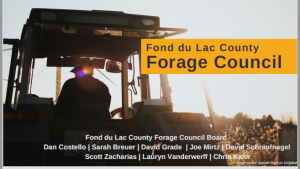When alfalfa fails due to winterkill, farmers must turn to alternative forages to make up for both the quality and quantity of the alfalfa lost in a growing season. Extension Crops/Soils and Dairy Program members, Midwest Forage Association (MFA), and 11 local Forage Councils, including Fond du Lac County, partnered to host the Local Forage Council Virtual Forum. The 137 participants learned season-long options for forage production after alfalfa winterkill and the use and management of BMR sorghum to fill forage niches to improve on-farm forage inventories. The featured speaker Cornell Extension Field Crop and Soils Educator Tom Kilcer.
Based on post-webinar evaluations, 31 percent of respondents indicated they will use the information this growing season. Eighty-four percent of respondents strongly agreed or agreed they felt more confident in their ability to manage corn silage to increase forage quantity while 76 percent strongly agreed or agreed they more confident to increase forage quality. Eighty-three percent of post-meeting evaluation respondents felt more confident in the knowledge of using corn silage to improve conservation.
Based on participation in the webinar, 18 percent of respondents indicated an estimated $1 to $4 per acre increase in profit by applying the information. Additionally, 29 percent of respondents indicated a $5 to $9 increase in profit per acre, and 24 percent indicated a $10 to $19 per acre increase profit. Seven percent indicated a potential $20+ per acre increase profit based on information learned.
It is estimated over 130,000 acres of corn silage grown or consulted were represented by post-meeting evaluation respondents.
As part of the virtual forum, Fond du Lac County Forage Council and Extension Fond du Lac County highlighted the impact of their collaboration in 2020 including:
- 64 local members strong
- 4 farms, 6 files participating in the Extension WI Alfala Yield Persistence Project
- 179 corn silage samples collected, processed, and analyzed for moisture, with the support of 13 agribusinesses
- 4 dates, 6 locations, conventional and low-lignin alfalfa scissors cut samples collected and analyzed for RVF determining the optimal time for first crop alfalfa harvest





